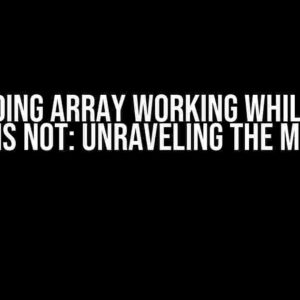Common NUnit Testing Issues and Their Solutions
If you’re struggling with NUnit testing issues, you’re not alone. Many developers face problems while writing and running NUnit tests. In this article, we’ll explore some common NUnit testing issues and their solutions to help you fix them quickly.
Issue 1: NUnit Test Not Found
If your NUnit test is not being recognized or executed, try the following:
- Check if the test class is public.
- Ensure the test method is public and has the [Test] attribute.
- Verify if the NUnit framework is correctly installed and referenced in your project.
Issue 2: NUnit Test Failing Due to Assembly Loading Issues
If your NUnit test is failing due to assembly loading issues, try the following:
- Check if the assemblies are correctly loaded and referenced in your test project.
- Verify if the assemblies are correctly configured in the app.config or web.config file.
- Try using the [assembly: Apartment(ApartmentState.STA)] attribute to specify the threading model.
Issue 3: NUnit Test Not Executing in the Correct Order
If your NUnit tests are not executing in the correct order, try the following:
- Use the [Order] attribute to specify the order of test execution.
- Implement the ITestFixtureSetup interface to execute setup code before running tests.
- Use the [SetupFixture] attribute to execute setup code once for all tests in a fixture.
Issue 4: NUnit Test Failing Due to External Dependencies
If your NUnit test is failing due to external dependencies, try the following:
- Use mocking libraries like Moq or NSubstitute to isolate dependencies.
- Implement the Dependency Injection pattern to manage external dependencies.
- Use the [SetUp] attribute to execute setup code before each test.
Issue 5: NUnit Test Performance Issues
If your NUnit tests are experiencing performance issues, try the following:
- Optimize your test code to reduce execution time.
- Use parallel testing to run tests concurrently.
- Implement the [Timeout] attribute to specify a timeout for tests.
By following these solutions, you should be able to fix common NUnit testing issues and improve your testing experience.
Frequently Asked Question
Get help troubleshooting your NUnit testing issues with these frequently asked questions!
Why are my NUnit tests not running at all?
This might be due to a missing or incorrect NUnit framework reference in your project. Make sure you’ve installed the correct version of NUnit from NuGet and referenced it correctly in your test project. Also, check your test class and method names to ensure they follow the correct naming conventions.
Why are my NUnit tests failing with a ” SetUp not found” error?
This error usually occurs when the SetUp method is not declared correctly. Check that your SetUp method is marked with the [SetUp] attribute and is public, void, and has no parameters.
How can I fix the “InvalidCastException” error in my NUnit tests?
This error often happens when you’re trying to cast an object to the wrong type. Review your code and ensure that you’re casting to the correct type. Also, check your test data to ensure it’s correctly formatted and matches the expected type.
Why are my NUnit tests not detecting changes to my code?
This might be due to the test runner not rebuilding your project after changes. Try cleaning and rebuilding your project, then run your tests again. Additionally, ensure that your test project is correctly referencing the main project and that the changes are being built correctly.
How can I debug my NUnit tests to find the root cause of the issue?
To debug your NUnit tests, enable debug logging in your test runner and examine the output for clues about the issue. You can also use Visual Studio’s built-in debugger to step through your test code and identify the exact point of failure.


